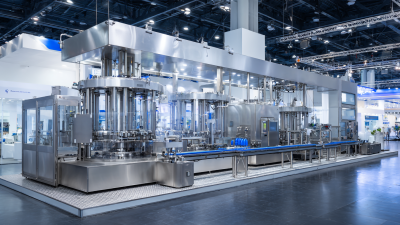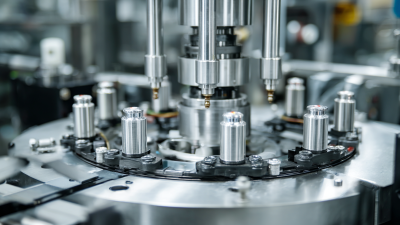Revolutionizing Efficiency: The Ultimate Guide to Selecting Your Ideal Case Packing Machine
In an era where operational efficiency and productivity are paramount, the selection of the right case packing machine has become a critical factor for businesses looking to streamline their packaging processes. According to a recent industry report by Grand View Research, the global case packing machine market is projected to reach USD 5.4 billion by 2027, growing at a CAGR of 6.5% from 2020 to 2027. This growth is driven by increasing demand for automated packaging solutions across various sectors, including food and beverage, pharmaceutical, and consumer goods. As companies strive to meet rising consumer expectations and reduce operational costs, the importance of choosing the ideal case packing machine cannot be overstated. This guide aims to provide manufacturers with essential insights and best practices to revolutionize their efficiency, ensuring they make informed decisions that align with their production needs and market trends.

Understanding the Importance of Case Packing Machines in Modern Industry
Case packing machines play a pivotal role in modern industry, supporting the efficient packaging of products while ensuring sustainability and meeting consumer demands. With the packaging sector experiencing a significant uptick in downstream market needs, it has become essential for businesses to invest in advanced case packing technologies. These machines not only enhance operational efficiency but also contribute to the environmental goals that are increasingly important to today’s consumers. As sustainability concerns rise, the integration of eco-friendly materials and practices into case packing strategies can lead to enhanced brand reputation and customer loyalty.
Furthermore, as highlighted by recent industry reports, innovations in packaging, such as the shift from traditional materials like polystyrene to more sustainable alternatives, are transforming how products are presented and delivered. The adoption of case packing machines that align with these evolving standards can provide companies a competitive edge in a rapidly changing market landscape. By understanding the importance of these machines, businesses can better navigate the challenges ahead, ensuring both operational efficiency and environmental responsibility in their packaging processes.
Case Packing Machine Efficiency in Modern Industry
Key Factors to Consider When Choosing a Case Packing Machine
 When selecting your ideal case packing machine, it’s crucial to understand the key factors that will influence your decision and enhance operational efficiency. With the global case packing machines market projected to grow from USD 1.07 billion in 2024 to USD 1.74 billion by 2033, identifying the right equipment is more important than ever for businesses aiming to optimize their packing processes. Considerations such as the machine's speed, compatibility with various product types, and its flexibility for future scalability should be prioritized.
When selecting your ideal case packing machine, it’s crucial to understand the key factors that will influence your decision and enhance operational efficiency. With the global case packing machines market projected to grow from USD 1.07 billion in 2024 to USD 1.74 billion by 2033, identifying the right equipment is more important than ever for businesses aiming to optimize their packing processes. Considerations such as the machine's speed, compatibility with various product types, and its flexibility for future scalability should be prioritized.
Tip: Assess the specific needs of your production line by calculating the throughput requirements. This will help determine the speed and size of the machine that best suits your operation.
Moreover, reliability and ease of maintenance are paramount when choosing a packing solution. A machine that requires frequent repairs can significantly impact productivity and costs over time. Analyzing industry reports and feedback can provide insights into the most reputable brands and models.
Tip: Look for machines with readily available spare parts and support services. This will ensure minimal downtime and a smoother operational flow in your facility.
Top Features That Enhance Efficiency in Case Packing Operations
When selecting a case packing machine, understanding the key features that enhance efficiency is crucial for optimizing operations. One of the top features to consider is the machine's speed and throughput. A high-speed case packing machine can significantly reduce the time taken to package goods, allowing for increased production rates and meeting tight deadlines. Additionally, machines equipped with advanced sensors and controls can automatically adjust to varying product sizes and types, ensuring a seamless packing process that minimizes downtime.

Another essential feature to enhance efficiency is versatility. A machine that can accommodate a wide range of products and packaging formats, such as different sizes and shapes of cases, allows for greater flexibility in production lines. This adaptability not only facilitates quicker changeovers between products but also reduces the need for multiple machines, streamlining the overall packing operation. Moreover, user-friendly interfaces and automated systems can help operators easily program and monitor the machine, further boosting operational efficiency. Investing in a case packing machine with these top features can lead to significant gains in productivity and cost-effectiveness.
Comparing Manual vs. Automated Case Packing Machines: Pros and Cons
When choosing between manual and automated case packing machines, businesses must weigh the pros and cons associated with each option. Manual case packing typically requires more labor, leading to higher operational costs, but it can offer flexibility for smaller production runs. Industry reports indicate that labor costs can account for up to 30% of total production expenses, making manual packing less economical for larger operations. However, for companies just starting out or those with variable demand, manual packing allows for quick adjustments to packing strategies without significant capital investment.
On the other hand, automated case packing machines provide significant advantages in terms of speed and efficiency. According to a recent study by Smithers Pira, automating case packing can increase output by up to 300% compared to manual operations, significantly reducing the time it takes to pack and ship products. While the initial investment for automated systems can be substantial, the reduction in labor costs and increased throughput often lead to higher long-term profitability.
**Tips:** Consider conducting a cost-benefit analysis to evaluate how automation could impact your overall production efficiency. It's also wise to assess your product types, as some may be better suited for manual packing due to their unique handling requirements.
Future Trends in Case Packing Technology and Their Impact on Efficiency
The future trends in case packing technology are significantly influenced by the broader shifts towards smart manufacturing and green production. As industries evolve under the umbrella of Industry 4.0, the emphasis on efficiency and sustainability in packaging processes has never been more critical. The market for case packing machines is projected to grow from $981.3 million in 2024 to $2.67 billion by 2032, reflecting a substantial uptick driven by advancements in technology and changing consumer expectations.
Emerging technologies such as ultrasonic welding are redefining traditional case packing practices. This innovation not only enhances the speed and precision of packing but also aligns with the sustainability goals that many manufacturers are now prioritizing. As companies shift towards greener production practices, the integration of smart packing solutions will play a vital role in reducing waste and optimizing resource use. Companies that invest in these new technologies will likely see improved efficiency and a stronger market position in the competitive landscape of manufacturing and logistics.
Revolutionizing Efficiency: The Ultimate Guide to Selecting Your Ideal Case Packing Machine - Future Trends in Case Packing Technology and Their Impact on Efficiency
| Technology | Efficiency Improvement (%) | Key Features | Future Trend |
|---|---|---|---|
| Robotic Case Packing | 30% | Flexibility, Precision, Speed | Increased Adoption in E-commerce |
| Automated Packing Lines | 25% | Integration, Reduced Labor, Consistency | Smart Manufacturing Technologies |
| Smart Sensors | 20% | Real-time Monitoring, Adaptive Control | IoT Integration |
| Eco-Friendly Materials | 15% | Sustainability, Reduced Carbon Footprint | Sustainability in Packaging |
| Artificial Intelligence | 35% | Optimization, Predictive Analytics | Machine Learning Applications |
Related Posts
-

Exploring Liquid Filling Machine Innovations at the 138th Canton Fair 2025
-

From China's Leading Factories: The Best Liquid Filling Machines Trusted by Global Buyers
-

Ultimate Guide to Choosing the Right Liquid Packaging Machine for Your Business Needs
-

Unlocking Efficiency: The Unmatched Advantages of Advanced Wrapping Machines in Modern Packaging
-

10 Essential Tips for Enhancing Your Industrial Packaging Strategy
-

How to Choose the Right Filling Machine for Your Packaging Needs
